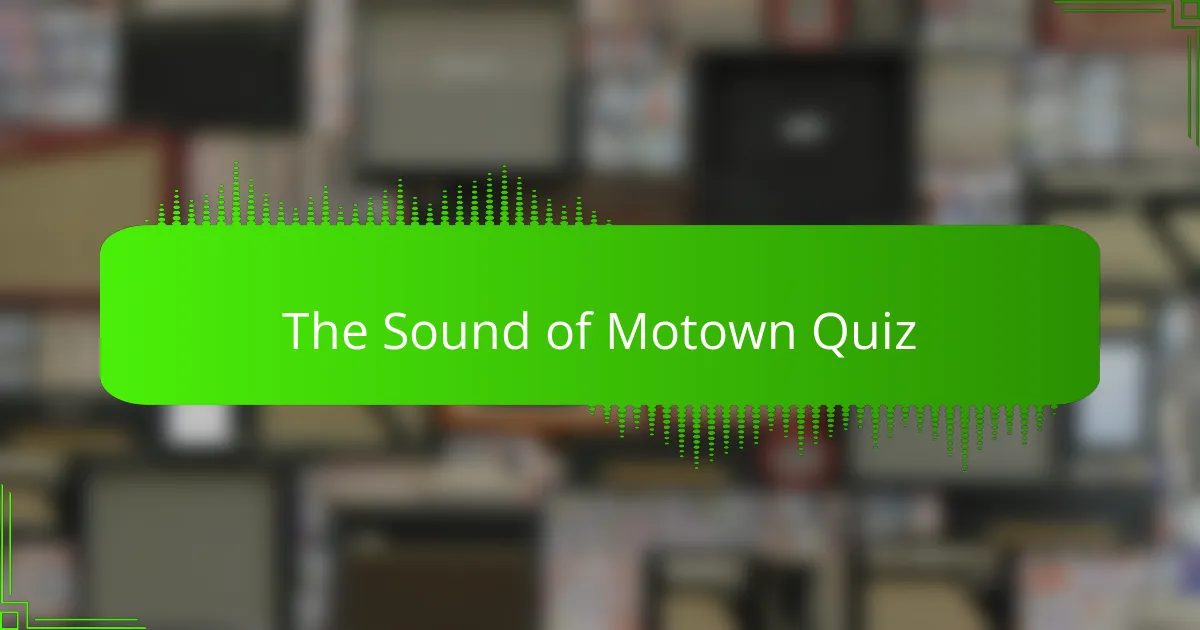
Quiz Completed: Celebrate Your Journey Through The Sound of Motown
Congratulations on completing our quiz about The Sound of Motown! We hope you enjoyed the experience and learned something new about this iconic genre. From the soulful melodies to the profound lyrics, Motown has left an indelible mark on music history. Each question aimed to test your knowledge while also deepening your appreciation for the artists and their contributions.
As you reflect on your quiz experience, consider how Motown has shaped the musical landscape. You may have discovered more about legendary artists like Stevie Wonder and Marvin Gaye or the impact of the Motown sound on popular culture. This quiz not only highlighted the magic of Motown but also encouraged you to further explore its timeless influence.
To expand your knowledge even more, we invite you to delve into the next section on this page dedicated to The Sound of Motown. Here, you’ll find articles, playlists, and insights that will enhance your understanding and appreciation for this extraordinary movement in music. Stay curious and keep exploring!

The Sound of Motown
An Overview of Motown: The Sound and Its Origins
Motown is a record label founded in 1959 by Berry Gordy Jr. in Detroit, Michigan. It became a cultural phenomenon by creating a distinct sound that blended soul music with pop, characterized by smooth vocals and infectious rhythms. The early hits from artists like The Supremes and The Temptations helped to redefine American music and opened doors for African American artists in mainstream media.
The Motown Sound: Key Characteristics
The Motown Sound is famously recognized for its use of catchy melodies, enthusiastic rhythms, and orchestrated arrangements. The vocal harmonies and instrumental arrangements featured prominent brass and string sections, giving songs a polished feel. This style was evident in hits such as “My Girl” by The Temptations and “Baby Love” by The Supremes, which highlighted the label’s commitment to craftsmanship in production.
Iconic Motown Artists and Their Impact
Key artists like Stevie Wonder, Marvin Gaye, and Diana Ross reshaped the music landscape through their contributions to Motown. Stevie Wonder’s introspective lyrics and innovative sound in album “Songs in the Key of Life” showcased his artistic evolution. Marvin Gaye’s “What’s Going On” became a timeless anthem for social change, illustrating Motown’s ability to address significant cultural issues within popular music.
The Role of Berry Gordy in Motown’s Success
Berry Gordy Jr. played a pivotal role as the founder and CEO of Motown. His vision of creating a successful African American-owned label led to the development of the Motown formula, focusing on artist development and marketing. Gordy’s strategies propelled stars like The Jackson 5 and Smokey Robinson to global fame while ensuring the label maintained a distinct brand identity.
The Legacy of Motown in Contemporary Music
The influence of Motown remains prevalent in modern music, with artists like Bruno Mars and Beyoncé drawing inspiration from its classic sound. The label’s focus on producing cross-genre hits continues to shape the industry. Additionally, tribute projects and remakes of Motown songs by contemporary artists underscore the timelessness of the Motown catalog, helping to introduce this groundbreaking sound to new generations.
What is The Sound of Motown?
The Sound of Motown refers to the distinctive style of music that emerged from Motown Records, founded by Berry Gordy Jr. in Detroit in 1959. It blends elements of soul, pop, and R&B, characterized by catchy melodies, smooth vocals, and a strong rhythm section. The overall sound was influenced by gospel and jazz, contributing to its widespread appeal. Notable artists associated with this sound include Stevie Wonder, Diana Ross and The Supremes, and The Temptations, all of whom reached significant commercial success during the 1960s.
How did The Sound of Motown influence pop music?
The Sound of Motown profoundly influenced pop music by integrating African American musical styles into mainstream culture. It introduced a polished production style and narrative-driven songwriting, which reshaped pop music conventions at the time. Hits like “My Girl” by The Temptations and “Stop! In the Name of Love” by The Supremes set new standards for song craftsmanship and performance. The success of Motown artists paved the way for future genres, such as disco and hip-hop, establishing a template for cross-genre collaboration.
Where did The Sound of Motown originate?
The Sound of Motown originated in Detroit, Michigan, where Motown Records was established. The label’s headquarters, known as Hitsville U.S.A., became a central hub for music production and talent discovery. The city itself was a key cultural melting pot during the 1960s, contributing to the diverse influences that shaped the Motown sound, including gospel, blues, and jazz. This unique environment fostered creativity and innovation in the music created at Motown.
When was The Sound of Motown most prominent?
The Sound of Motown reached its peak prominence during the 1960s. Between 1961 and 1969, Motown’s artists generated numerous chart-topping hits, with the label becoming one of the most successful record companies in the world. The introduction of popular television shows like “The Ed Sullivan Show” and “American Bandstand” further amplified the reach and popularity of Motown artists, solidifying their place in music history.
Who were the key artists behind The Sound of Motown?
Key artists behind The Sound of Motown include Marvin Gaye, Smokey Robinson, and The Supremes, along with others like The Temptations and Martha and the Vandellas. Each artist contributed unique elements to the Motown sound. For example, Marvin Gaye’s smooth vocal delivery and socially relevant lyrics brought depth to the Motown catalog. Meanwhile, The Supremes, led by Diana Ross, became icons of both music and fashion, further popularizing the Motown brand worldwide.

